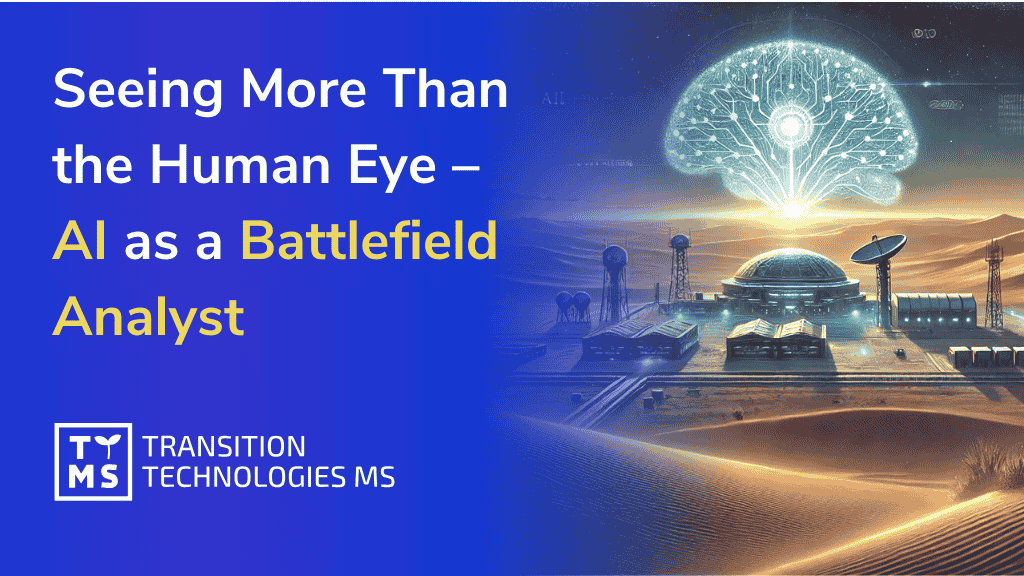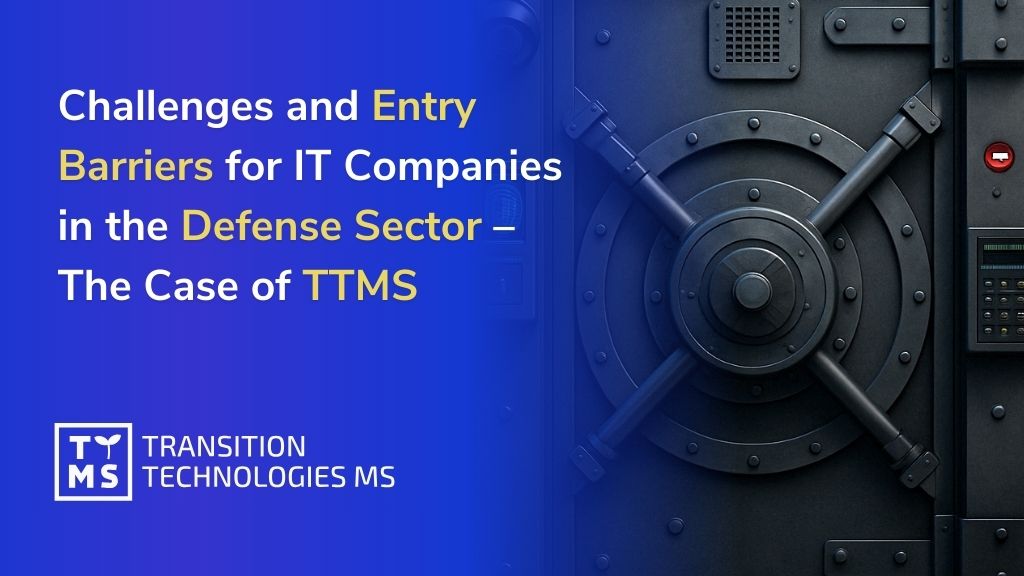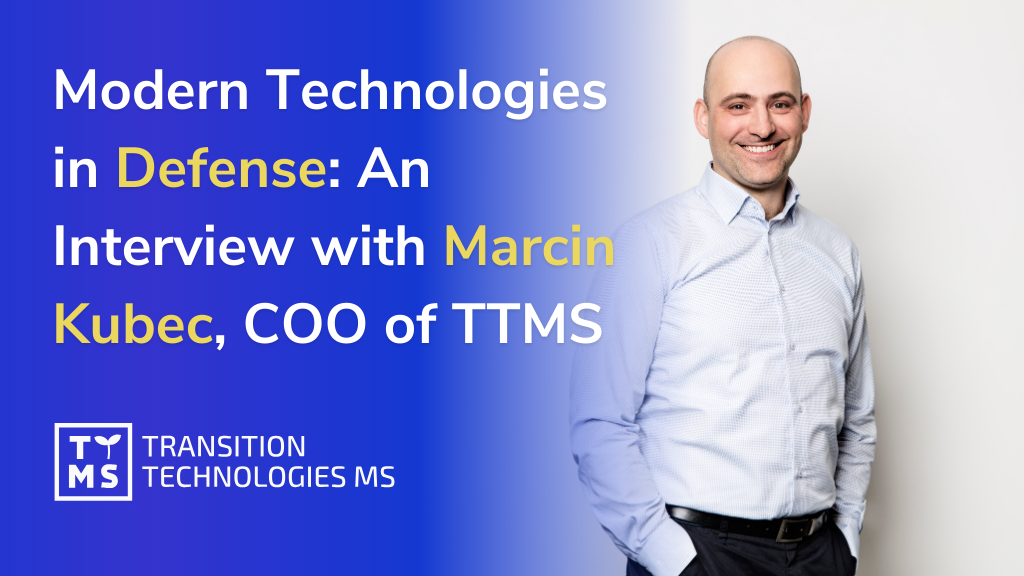The defense sector is becoming an increasingly important recipient of modern IT solutions. Growing defense budgets open up new business opportunities for technology companies. According to the International Institute for Strategic Studies, defense spending in Europe rose by 11.7% in 2024, reaching USD 457 billion. Despite this market’s potential, IT companies face exceptionally high formal, technological, and organizational barriers when attempting to enter the defense industry. Transition Technologies Managed Services (TTMS), a Polish software house, is a compelling example of a company that is successfully overcoming these hurdles. In recent years, TTMS has significantly expanded its defense-related operations. The company has doubled its defense contract portfolio while systematically enhancing its offer for military and governmental institutions.
Sebastian Sokołowski, CEO TTMS
As TTMS CEO Sebastian Sokołowski stated in a recent interview for ISBtech.pl:
“We are currently focusing strongly on developing our operations in the defense sector, which has allowed us to double our order portfolio in this area. The growing demand creates many opportunities, but being a preferred partner in this market is a major challenge for many IT firms due to high entry barriers and the need for niche competencies.”
Below, we explore the main challenges of entering the defense industry and how TTMS is addressing them to establish itself as a trusted supplier.
Formal and Regulatory Barriers
One of the biggest challenges for IT firms entering the defense industry is the number of formal requirements they must meet. In Poland, any activity related to the manufacturing or trading of military-grade technologies or products requires a government license. TTMS holds such a license since 2019. In 2024, the company renewed its permit to handle dual-use technologies for a maximum period of 50 years. This enables the company to legally participate in tenders and contracts involving advanced military technologies.
Additionally, companies must have security clearances to handle classified information, a typical requirement in defense projects. This means that both the company and its staff must obtain industrial and personal security clearances at various levels. TTMS employees are certified to work on classified materials at NATO/ESA/EU Secret levels, meeting strict standards for confidentiality and secure information handling. Only a handful of Polish IT companies have this level of access and experience, putting TTMS in a select group of suppliers qualified to support military-grade IT projects.
Technological Standards and Security Requirements
From a technological standpoint, entering the defense market means complying with extremely high requirements for quality, resilience, and cybersecurity. Defense-related IT systems, especially those used for command, control, communications, and reconnaissance (C4ISR), must be fully operational under harsh physical and digital conditions, including cyberattacks or communication failures. As such, companies must implement encrypted communication, redundancy measures, and comply with security frameworks like ISO 27001 and STANAG (NATO Standardization Agreements).
TTMS has developed these competencies through years of experience and has built internal teams capable of working on military-grade systems. The company’s consultants understand the logic and workflows of defense systems at the tactical, operational, and strategic levels, allowing them to work on both pure software projects and integrations with military equipment and battlefield sensors.
TTMS also applies methodologies and standards from the space industry — such as Product and Quality Assurance for the European Space Agency (ESA) — to ensure that each system meets the highest quality and safety benchmarks. This rigorous approach is equally applicable in defense contracts, where system failure can lead to mission failure. TTMS regularly participates in technology trials and validation efforts, including within NATO’s ACT Innovation Hub, where new tools and frameworks are tested under controlled conditions before being rolled out into production environments.
Procurement Cycles and Organizational Challenges
Even with the right certifications and technical expertise, IT companies face another critical hurdle — the length and complexity of public sector procurement cycles. Defense contracts are typically subject to multi-stage public tenders, technical consultations, and rigorous vetting procedures, which can take months or even years to complete.
Moreover, tenders often require evidence of prior experience, financial stability, and the ability to provide long-term support. Companies may also need to commit to deploying personnel on-site, maintaining hardware and software for years, and complying with strict documentation and reporting protocols. For many IT vendors, the resources required to simply submit a compliant offer are a barrier in themselves.
To mitigate these challenges, TTMS has adopted a partnership-driven strategy, participating in consortiums that combine different capabilities across organizations. Large defense contracts are rarely executed by a single vendor — instead, they are typically delivered by groups that include system integrators, hardware providers, software developers, and training companies. TTMS has participated in many such tenders — either independently or as part of a consortium — and has successfully won contracts or advanced to final stages in many defense procurement processes.
Another key characteristic of this market is the long lifecycle of contracts. Once a solution is implemented, the provider is often responsible for its maintenance and evolution for several years. As CEO Sokołowski notes, “Defense contracts are by definition long-term engagements — specialists are often involved for years, and system rollouts are accompanied by ongoing support and maintenance.” This long-term horizon presents both an opportunity and a responsibility, as the company becomes a long-term strategic partner for military clients.
How TTMS Prepares for Defense Sector Demands
To succeed in such a highly specialized field, TTMS has made strategic investments in certifications, personnel, and organizational capabilities tailored to the needs of the defense sector. Since 2017, the company has consciously developed its Defense & Space business line, combining its roots in industrial software with the unique demands of national security applications.
TTMS management board
This includes establishing a dedicated Defense & Space division, hiring staff with security clearances, and creating secure environments for working with classified data. TTMS has also created internal teams for cybersecurity, geospatial systems, AI-based decision support tools, and interoperability between national and NATO command systems.
A key part of the company’s strategy is to build strong reference cases through successful implementations. Before winning its own defense contracts, TTMS served as a subcontractor in consortia — gaining valuable know-how and building a project portfolio that later opened doors to larger tenders. Today, TTMS has successfully delivered more than ten defense-related projects and is involved in many others that are ongoing or in advanced stages of procurement.
Notable Projects: NATO, ESA, and Beyond
Among TTMS’s most prominent achievements is its involvement in projects for NATO’s Allied Command Transformation (ACT) and the NATO Standardization Office (NSO). For instance, the company was awarded a €0.9 million contract to build a new terminology management system for NATO. This platform allows the alliance to manage, distribute, and maintain unified military terminology and acronyms — critical for ensuring consistency across multinational forces. TTMS is responsible for delivering the entire system as part of a consortium, demonstrating its ability to deliver high-impact, multinational solutions.
The company also participates in cyber intelligence and decision-support systems for NATO, including tools that process Open Source Intelligence (OSINT) using artificial intelligence to help commanders make better-informed strategic decisions. Other initiatives include communication interfaces that link the Polish Armed Forces with NATO systems, ensuring interoperability across command structures.
TTMS’s expertise in the space sector further strengthens its capabilities. The company supports projects for ESA and the EU Space Program Agency, delivering services related to quality assurance and software safety. These space projects demand the highest standards of reliability and resilience — traits that are equally vital in military contexts.
Earning Trust in the Defense Sector
Ultimately, trust is the most valuable currency in the defense industry. Institutions are cautious and deliberate when selecting long-term partners. TTMS has worked for years to build a reputation for security, professionalism, and delivery excellence. Its certifications, long-term client relationships, and secure project environments help position it as a reliable supplier.
TTMS’s credibility is further enhanced by its corporate governance and financial transparency. As a member of the Transition Technologies Group and a company preparing for an IPO, TTMS is subject to the oversight and reporting obligations that come with listing — reassuring public sector clients of its financial and operational maturity.
The company also has a growing presence in international markets (Europe, Asia, Latin America), and its selection by major institutions such as NATO and ESA confirms its global competitiveness. TTMS’s leadership emphasizes that cutting-edge technologies such as artificial intelligence and cybersecurity will play a growing role in defense systems, and the company is committed to building long-term relationships with key institutions in these areas.
Conclusion
The defense sector is one of the most demanding — and most rewarding — markets for IT providers. Entry requires formal licenses, security clearances, technological specialization, and procedural fluency in public procurement. TTMS exemplifies how a company can build up these capabilities strategically, invest in the right people and certifications, and gradually earn the trust of major defense stakeholders. In doing so, it not only opens new revenue streams but also contributes to national and international security by delivering innovative, mission-critical digital systems.
Why is it so difficult for IT companies to enter the defense sector?
The defense sector imposes strict formal requirements (licenses, security clearances), advanced technological standards (system resilience, NATO norms), and complex procurement procedures. Trust and long-term references are also essential to succeed.
What is a NATO/ESA/EU SECRET security clearance?
It is an official authorization that allows a company and its personnel to access and handle classified information at the “SECRET” level in international projects for organizations like NATO, the European Space Agency (ESA), or the EU. It reflects high levels of security compliance and confidentiality.
What does C4ISR stand for?
C4ISR means Command, Control, Communications, Computers, Intelligence, Surveillance, and Reconnaissance. It refers to integrated systems that help military forces make decisions, communicate, analyze intelligence, and monitor the battlefield. It is the digital backbone of modern defense operations.
What technologies does TTMS offer for the defense sector?
TTMS provides:
decision-support systems for military command,
NATO-compliant software solutions,
AI-powered data analytics tools,
interoperability tools between national forces and NATO systems,
support for space and satellite-based defense initiatives.
How is a military procurement process different from a civilian one?
Military tenders are more complex and formalized. They often require special licenses, security clearances, inter-ministerial approvals, and guarantees for long-term system maintenance. The process typically takes longer and includes stricter evaluation criteria.
Read more




